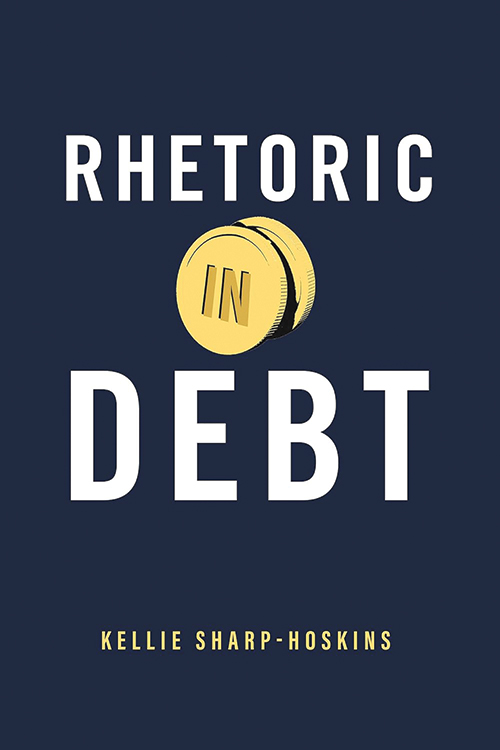
Rhetoric in Debt
Reviewed by Pamela Haines
January 1, 2024
By Kellie Sharp-Hoskins. The Pennsylvania State University Press, 2023. 204 pages. $119.95/hardcover; $95.99/eBook.
Rhetoric in Debt opens with a morality tale of school districts experimenting with recouping loss from indebted parents by serving obviously different and cheaper lunches to those parents’ children. The narrative frame is clear: the issue is a moral lapse in fiscal responsibility, and the lever to restore equilibrium to the system is shame.
The bulk of this multidisciplinary look at debt lies in a critique of this narrative through case studies of student loans, municipal bonds, and healthcare debt. The author argues that the “choice” to take on student loan debt emerges within radically asymmetrical, racialized, and gendered histories of wealth accumulation. When municipal bonds pay off, they profit fiscally savvy individual investors; when they don’t, the consequences are meted out to community members who are most vulnerable. Medical debt rises when individuals take on risk in areas where insurance companies have withdrawn collective options.
In the conclusion, the author relaxes her highly academic style to offer some thought-provoking overall reflections. She starts by noting the flaws in the standard view that reduces debt to mathematical calculations and risk assessments made through rational cost-benefit analysis.
First, there is the issue of non-financial debts that are relational in nature and can never be repaid in any monetized way. I’m sure we all have examples of people to whom we feel indebted for priceless gifts of love, advice, or experience. These debts, based on relationships in interconnected communities, are central and non-burdensome elements of a gift economy.
But what happens when that priceless caring and attention overlap with the monetized economy? Then a belief that something has non-monetary value bleeds into a belief that it need not be paid. From this comes the unpaid labor of parenting and the underpaid labor of caring for young children, the elderly, and the disabled. Not far down this road are the helping professions in general, including teachers and social workers. It is a paradox: the more we feel indebted to such people for services that can’t be monetized, the easier it is to justify paying them less.
Then there is the most glaring example of our country’s debt for unpaid labor: our history of slavery. The magnitude of the harm staggers the imagination, and our accounting systems are wholly inadequate to the task. Yet while writing a check may be less important than a society-wide reckoning with that institution and all its tendrils in our lives in the present, repayment still matters.
Since the author has limited herself to consideration of issues within the United States, a similar story of debt that is now playing out on a global scale goes unmentioned. Centuries of colonialism and unequal trade relations have left nations of the Global South heavily burdened by debt to the North. Such a great amount of their resources now go to debt servicing that they have little to spend on basic needs, much less climate mitigation. They are seeking help—and justice—in addressing the damage caused by climate change generated in faraway affluence. Who owes what to whom in this situation?
I have been attracted to the bold and simple response of declaring jubilee, just canceling the debt. Yet the author points out that until this entanglement of debt, judgment, power, and computation is addressed, temporarily wiping the slate clean will just set the stage for a new cycle of accumulation. It seems that our narratives around debt—our rhetoric—inevitably result in its burden being shouldered by those who have the least resources and social power. A program of debt cancellation would be a good start, but ultimately we need to both turn the narrative on its head and address the underlying injustice through political acts of refusal.
It is unfortunate that the highly academic, dense, and jargon-packed writing style of Rhetoric in Debt makes its language pretty impenetrable to the lay reader. Yet while I doubt that many people will choose to pay for and struggle through this book, I hope the author’s insights will inform our perspective whenever we are faced with issues of debt—in our lives, in the communities around us, or in the news—and help us respond in ways that are both more nuanced and perhaps more bold.
Pamela Haines is a member of Central Philadelphia (Pa.) Meeting. She is passionate about bringing our faith values to economics. Her newest titles are The Promise of Right Relationship, and Tending the Web: Poems of Connection, and she blogs at pamelahaines.substack.com.



Comments on Friendsjournal.org may be used in the Forum of the print magazine and may be edited for length and clarity.